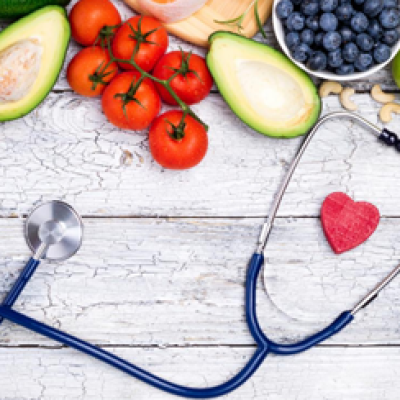By Sprout Health Studio / Wednesday, 9 September 2020 / Topics:

In 2017-18 , 1.5 million Australians had high cholesterol – a major risk factor for heart disease. We’ve all heard of cholesterol is “bad for us”, but what exactly is it and how can we keep our levels in check?
Cholesterol is a waxy, fat-like substance made in the liver and has many important roles in the body. It helps create cell membranes which protect your cells from the external environment, it helps produce important hormones like testosterone and oestrogen and it’s involved in making bile acids which help your body digest and absorb fat. Your body needs cholesterol to function but like anything, you can have too much of a good thing and having too much cholesterol can increase your risk of heart disease.
There are two main types of cholesterol:
LDL cholesterol is sometimes called “bad” cholesterol because too much of it can cause fatty deposits to build up inside the walls of our arteries, restricting blood flow to the heart and brain.
HDL cholesterol helps to remove the LDL cholesterol from your bloodstream which is why it’s often referred to as “good” cholesterol.
We’ve put together some of our top nutrition tips to help keep your cholesterol in check.
Choose the right fats
When it comes to improving cholesterol levels, not all fats are created equal. Studies have shown that eating too much saturated fat can raise LDL cholesterol, whereas eating unsaturated fats can reduce LDL cholesterol and increase HDL cholesterol. Swapping saturated fat for unsaturated fats is one of the most practical and effective ways to lower cholesterol.
Common sources of saturated fat include fatty cuts of meat, full cream dairy, coconut oil and many processed foods such as cakes, biscuits, pastries and deep-fried foods. We’re not saying you have to cut these foods completely, but if you’ve made a habit of reaching for the office biscuit jar, smothering your baked goods in a thick layer of butter or purchasing a pastry from the bakery a little too often – it may be worth swapping some of your choices occasionally.
Where possible try to ensure that most of the fat you eat is the unsaturated kind. For example, swap butter for margarine or olive oil, fatty cuts of meat for fish, add avocado to your salads or sandwiches and limit takeaway and processed foods. Remember, fat in general is high in energy (calories) and eating too much can lead to weight gain over time. Excess weight is also a risk factor for heart disease so it’s no matter what type of fat remember to consume it in moderation!
Fill up on fibre
When you think about fibre, your mind probably goes to prunes and bowel motions. But did you know that fibre, particularly soluble fibre, can also help lower your LDL cholesterol levels? When we eat soluble fibre it binds to water and forms a thick, sticky, glue-like gel in our intestines. As this ‘glue’ moves through the digestive system it traps cholesterol and helps move it out of the body before it is able to be reabsorbed, helping to reduce cholesterol levels. Good sources of soluble fibre include beans and legumes, oats, barley, fruits and vegetables.
Starting the day with a warming bowl of porridge is just one simple way to up your fibre intake and get all its cholesterol-lowering benefits. We know what you’re thinking… porridge is bland, boring, gluggy and only enjoyed by people aged 75+. We get it – a plain, boring bowl of porridge can be, well, just plain boring. Make your bowl of porridge more delicious and heart-y by adding a variety of different flavours, textures and colours. Think spices like cinnamon, nutmeg, ginger and vanilla, fresh, frozen or stewed fruit and a sprinkle of nuts or a drizzle of nut butter - the options are endless!
Cholesterol-lowering plant sterols
Plant sterols are compounds that occur naturally in plant-based foods and when eaten in the right amounts have been shown to reduce cholesterol levels by up to 10%. Plant sterols have a structure very similar to cholesterol - kind of like cholesterol’s doppelganger. Because of their similarity, plant sterols compete with cholesterol for absorption, helping to reduce the amount of cholesterol absorbed.
Plant sterols are found in small amounts in plant foods like whole grains, legumes, fruits, vegetables and nuts and seeds but unfortunately these foods alone don’t contain enough plant sterols to lower cholesterol levels. Luckily, some food companies have added plant sterols to specific food products to help you meet the recommended amounts of 2 to 3 grams per day. Look out for plant sterol-enriched breakfast cereals, margarine and dairy products.
Go nuts for nuts (in moderation)!
Nuts are little nutrition powerhouses when it comes to cholesterol. Not only do they contain plenty of healthy fats, they’re also a good source of dietary fibre and are a natural source of plant sterols! Win, win & big win! However, as nuts are very calorie-dense (and incredibly moreish) they’re easy to overeat making it hard to control your waistline! Try to aim for around 30 grams, or a small handful of nuts each day.
If you’re daily trail mix is sending you a little nuts, there’s plenty of other ways to include more nuts into your day. Sprinkle them over your salad for some extra crunch, use nut butter on toast, include nuts into your morning muesli or add them to a stir fry. And no… you don’t need to ‘activate’ them to get their health benefits.
In summary, a healthy diet filled with unsaturated fats, soluble fibre and plant sterols can help get your cholesterol levels back on track. With a few simple dietary changes you’ll be on your way to a healthier and happier heart in no time!

